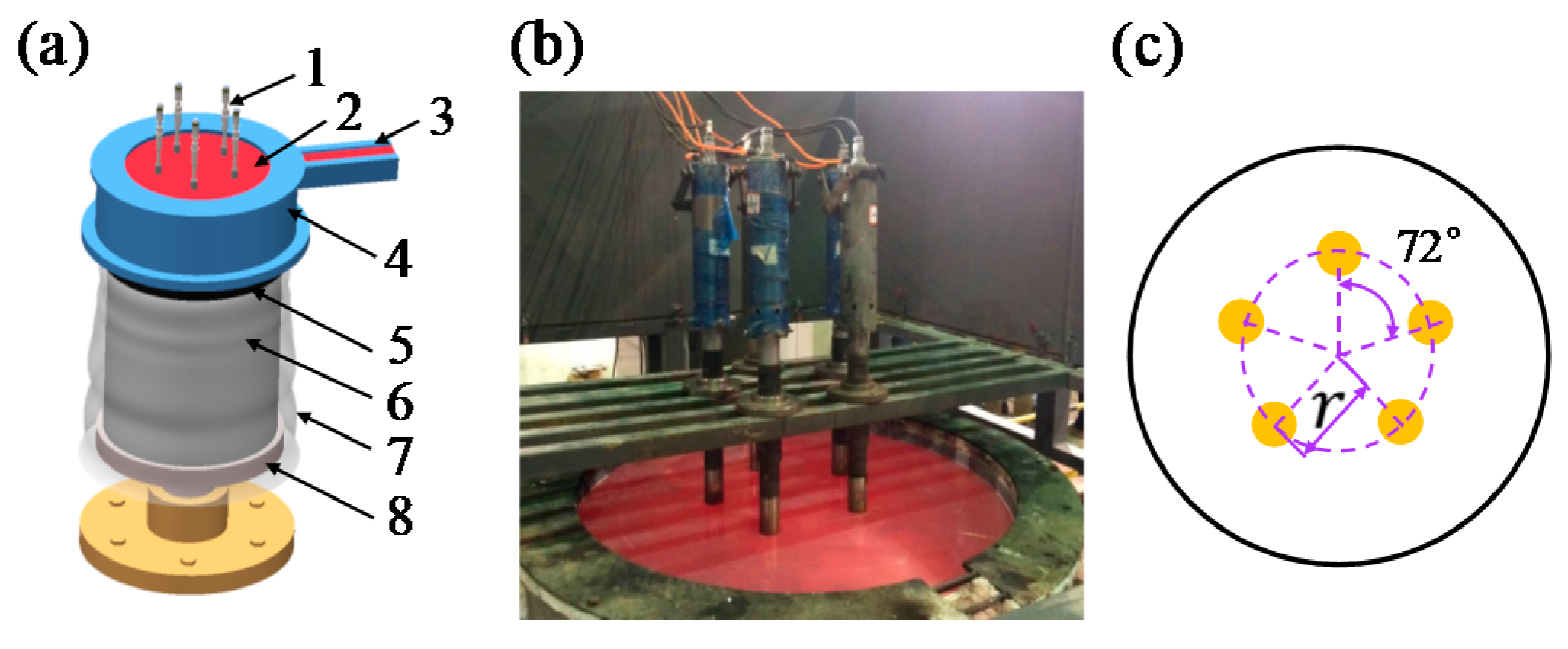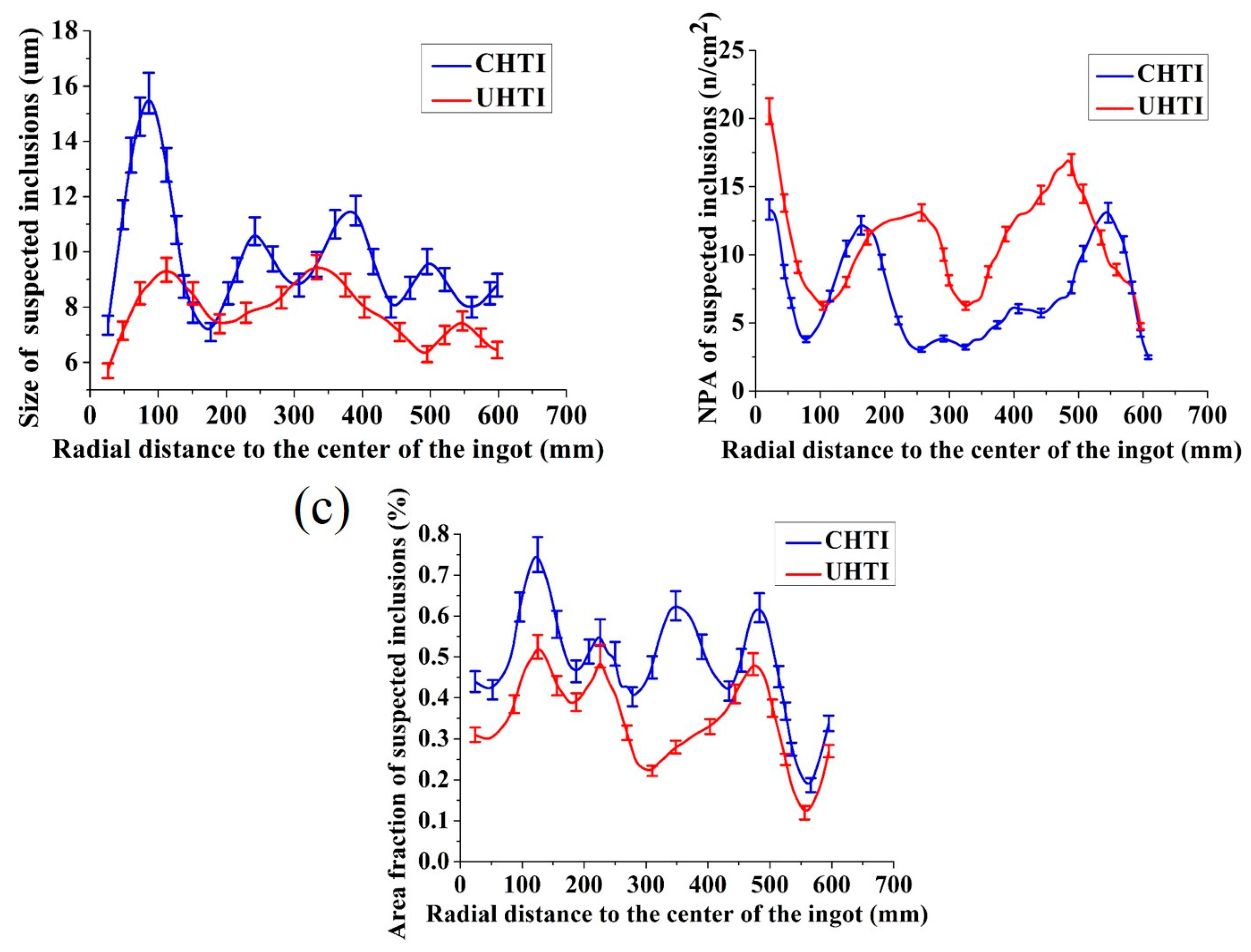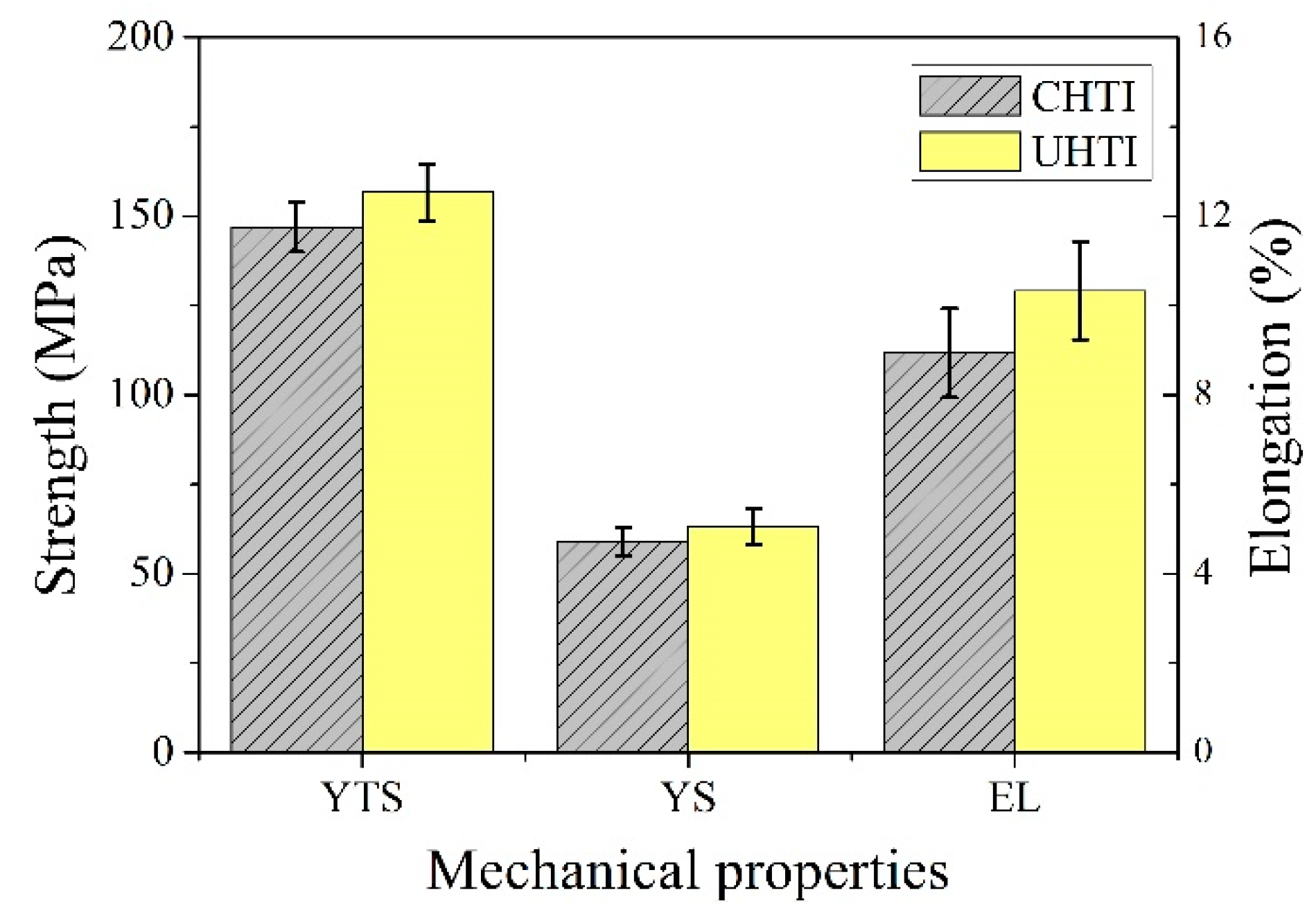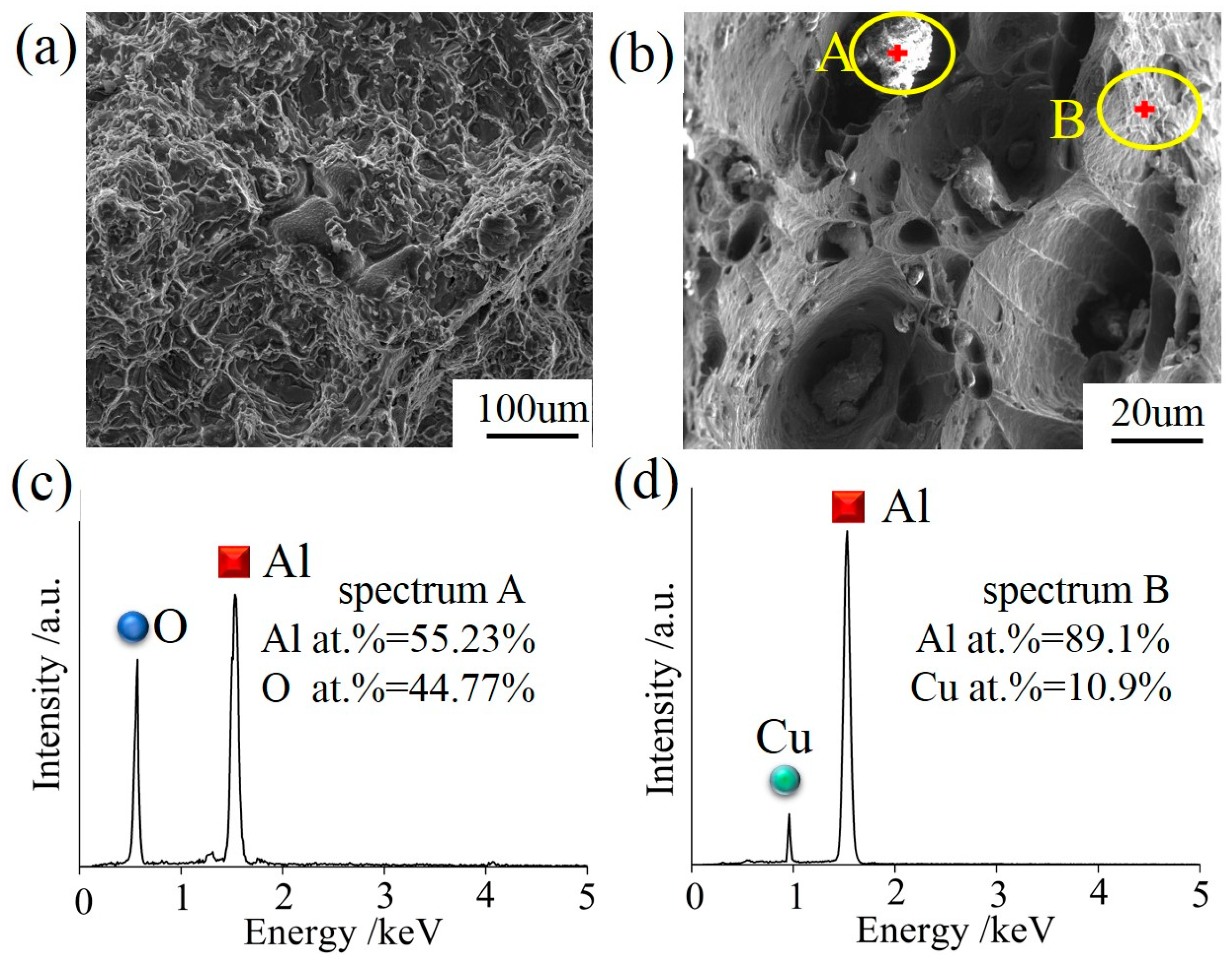Possible Effects and Mechanisms of Ultrasonic Cavitation on Oxide Inclusions during Direct-Chill Casting of an Al Alloy
Abstract
:1. Introduction
2. Materials and Methods
3. Results
3.1. Microstructure
3.2. Size, NPA, and Area Fraction Distribution of Suspected Inclusion
3.3. Mechanical Properties
3.4. SEM Morphology Characteristics and EDS Composition Analysis
3.5. XRD Analysis
4. Discussion
4.1. Fast Crushing Period
4.2. Slow Crushing Period
4.3. Crushing Decline and Inclusion Cleaning Period
5. Conclusions
- (1)
- The effect of ultrasonic cavitation on oxide films and inclusions are significant. For no oxide films are observed in UHTI, and the average size of inclusions decreases from 10.606 μm to 8.096 μm, and the area fraction decreases by 21% comparing CHTI with UHTI.
- (2)
- The effects and mechanisms of ultrasonic purification can be divided into three periods. The first period is a fast crushing process effected by the high pressures, micro-jets, and high temperature produced by ultrasonic cavitation in CSCR. And the oxide films or large inclusion particles are broken up to tiny particles. The second period is a slow process that effected by cyclic pressure provided by the pulsating bubbles in NSCR. And the third period is a crushing decline and inclusions cleaning process. The tiny inclusion particles are adhered to the cavitation bubbles and be carried out from the melt. Besides, the ultrasonic cavitation increases the wettability of particle interface which results in obvious grain refinement effect. Finally, this point is verified by the experimental results that the average grain size deviation in the ingot section is reduced from 230 μm of CHTI to 160 μm of UHTI.
Author Contributions
Funding
Acknowledgments
Conflicts of Interest
References
- Inoue, A.; Shen, B.L.; Koshiba, H.; Kato, H.; Yavari, A.R. Ultra-high strength above 5000 MPa and soft magnetic properties of Co–Fe–Ta–B bulk glassy alloys. Acta Mater. 2004, 52, 1631–1637. [Google Scholar] [CrossRef]
- Liu, L.; Wu, Y.; Gong, H.; Li, S.; Ahmad, A.S. A physically based constitutive model and continuous dynamic recrystallization behavior analysis of 2219 aluminum alloy during hot deformation process. Materials 2018, 11, 1443. [Google Scholar] [CrossRef] [PubMed]
- He, H.L.; Yi, Y.P.; Huang, S.Q.; Zhang, Y.X. An improved process for grain refinement of large 2219 Al alloy rings and its influence on mechanical properties. J. Mater. Sci. Technol. 2019, 35, 55–63. [Google Scholar] [CrossRef]
- Liu, J.; Shan, C.; Hou, Y. Main Defects and Quality Control Technology of Aluminum Alloy Materials; Metallurgical Industry Press: Beijing, China, 2012; p. 28. [Google Scholar]
- Moneghini, M.; Zordi, N.D.; Solinas, D.; Macchiavelli, S.; Princivalle, F. Characterization of solid dispersions of itraconazole and vitamin E TPGS prepared by microwave technology. Future Med. Chem. 2010, 2, 237–246. [Google Scholar] [CrossRef] [PubMed]
- Mishra, R.R.; Sharma, A.K. Microwave–material interaction phenomena: Heating mechanisms, challenges and opportunities in material processing. Compos. Part A Appl. Sci. Manuf. 2016, 81, 78–97. [Google Scholar] [CrossRef]
- Mishra, R.R.; Sharma, A.K. On mechanism of in-situ microwave casting of aluminum alloy 7039 and cast microstructure. Mater. Des. 2016, 112, 97–106. [Google Scholar] [CrossRef]
- Luo, Y.; Zhang, Z.; Li, B.; Gao, M.W.; Qiu, Y.; He, M. Effects of annular electromagnetic stirring coupled with intercooling on grain refinement and homogeneity during direct chill casting of large-sized 7005 alloy billet. JOM 2017, 69, 2640–2643. [Google Scholar] [CrossRef]
- Eskin, G.I.; Eskin, D.G. Ultrasonic Treatment of Light Alloy Melts; CRC Press: Boca Raton, FL, USA, 2014; p. 56. [Google Scholar]
- Eskin, G.I. Broad prospects for commercial application of the ultrasonic (cavitation) melt treatment of light alloys. Ultrason. Sonochem. 2001, 8, 319–325. [Google Scholar] [CrossRef]
- Jiang, R.P.; Li, X.Q.; Chen, P.H.; Li, R.Q.; Zhang, X. Effect and kinetic mechanism of ultrasonic vibration on solidification of 7050 aluminum alloy. AIP Adv. 2014, 4, 077125. [Google Scholar] [CrossRef] [Green Version]
- Abramov, O.V. Ultrasound in Liquid and Solid Metals; CRC Press: Boca Raton, FL, USA, 1994; p. 17. [Google Scholar]
- Abramov, O.V. High-Intensity Ultrasonics: Theory and Industrial Applications; CRC Press: Boca Raton, FL, USA, 1999; p. 22. [Google Scholar]
- Feng, W.; Tzanakis, I.; Eskin, D.; Mi, J.; Connolley, T. In-situ observation of ultrasonic cavitation-induced fragmentation of the primary crystals formed in Al alloys. Ultrason. Sonochem. 2017, 39, 66–76. [Google Scholar]
- Salloum-Abou-JaoudeEmail, G.; Eskin, D.G.; Barbatti, C.; Jarry, P.; Jarrett, M.; Fan, Z. Effect of Ultrasonic Processing on a Direct Chill Cast AA6082 Aluminium Alloy; Springer International Publishing: Berlin, Germany, 2017; p. 997. [Google Scholar]
- Li, R.; Liu, Z.; Dong, F.; Li, X.; Chen, P. Grain refinement of a large-scale Al alloy casting by introducing the multiple ultrasonic generators during solidification. Metall. Mater. Trans. A 2016, 47, 3790–3796. [Google Scholar] [CrossRef]
- Gopalan, R.; Prabhu, N.K. Oxide bifilms in aluminum alloy castings—A review. Mater. Sci. Technol. 2011, 27, 1757–1769. [Google Scholar] [CrossRef]
- Fiorese, E.; Bonollo, F.; Timelli, G.; Arnberg, L.; Gariboldi, E. New classification of defects and imperfections for aluminum alloy castings. Int. J. Metalcast. 2015, 9, 55–66. [Google Scholar] [CrossRef]
- Cao, X.; Campbell, J. Oxide inclusion defects in Al-Si-Mg cast alloys. Can. Metall. Q. 2013, 44, 435–448. [Google Scholar] [CrossRef]
- Campbell, J. Casting; Elsevier Science Ltd.: Amsterdam, The Netherlands, 2003; p. 20. [Google Scholar]
- Shao, Z.W.; Le, Q.C.; Zhang, Z.Q.; Cui, J.Z. Effect of ultrasonic power on grain refinement and purification processing of AZ80 alloy by ultrasonic treatment. Met. Mater. Int. 2012, 18, 209–215. [Google Scholar] [CrossRef]
- Zhang, Z.; Le, Q.; Cui, J.; Wang, X.; Zhang, H. Purification process of magnesium alloy melt under ultrasonic field. Spec. Cast. Nonferrous Alloys 2010, 30, 988–991. [Google Scholar]
- Xiao, Y.Q.; Xie, S.S.; Liu, J.A.; Wang, T. Practical Manual of Aluminum Processing Technology; Metallurgical Industry Press: Beijing, China, 2005; p. 70. [Google Scholar]
- GB/T 3246.1-2012. Inspection Method for Structure of Wrought Aluminum and Aluminum Alloy Products-Part 1: Inspection Method for Microstructure; Standards Press of China: Beijing, China, 2013; p. 20.
- He, H.; Yi, Y.; Huang, S.; Zhang, Y.X. Effects of deformation temperature on second-phase particles and mechanical properties of 2219 Al-Cu alloy. Mater. Sci. Eng. A 2017, 712, 414–423. [Google Scholar] [CrossRef]
- Zhong, Q.P.; Zhao, Z.H. Fractography; Higher Education Press: Beijing, China, 2005; p. 64. [Google Scholar]
- Lu, Y.; Wang, J.; Li, X.C.; Li, W.; Li, R.L.; Zhou, D.S. Effects of pre-deformation on the microstructures and corrosion behavior of 2219 aluminum alloys. Mater. Sci. Eng. A 2018, 723, 204–211. [Google Scholar] [CrossRef]
- Tian, Y.; Liu, Z.; Li, X.; Zhang, L.; Li, R.; Jiang, R.; Dong, F. The cavitation erosion of ultrasonic sonotrode during large-scale metallic casting: Experiment and simulation. Ultrason. Sonochem. 2018, 43, 29–37. [Google Scholar] [CrossRef] [PubMed]
- Jiang, R.P. Performance Analysis of Ultrasonic Vibration System and Experimental Research on Aluminum Alloy Casting by Ultrasonic. Master’s Thesis, Central South University, Changsha, China, 2008; p. 59. [Google Scholar]
- Chen, Y.J.; Huang, L.W.; Tengshih, S. Diagnosis of oxide films by cavitation micro-jet impact. Mater. Trans. 2003, 44, 327–335. [Google Scholar] [CrossRef]
- Lord, R.O. On the pressure developed in a liquid during the collapse of a spherical cavity. Philos. Mag. 1917, 34, 94–98. [Google Scholar]
- Feng, R.; Li, H. Acoustic Chemistry and Application; Anhui Science and Technology Press: Anhui, China, 1992; p. 78. [Google Scholar]
- Komarov, S.; Kuznetsov, D. Erosion resistance and performance characteristics of niobium ultrasonic sonotrodes in molten aluminum. Int. J. Refract. Met. Hard Meter. 2012, 35, 76–83. [Google Scholar] [CrossRef]
- Fang, D.; Li, X.; Zhang, L.; Ma, L.; Li, R. Cavitation erosion mechanism of titanium alloy radiation rods in aluminum melt. Ultrason. Sonochem. 2016, 31, 150–156. [Google Scholar]
- Yusof, N.S.; Babgi, B.; Alghamdi, Y.; Aksu, M.; Madhavan, J.; Ashokkumar, M. Physical and chemical effects of acoustic cavitation in selected ultrasonic cleaning applications. Ultrason. Sonochem. 2015, 29, 568–576. [Google Scholar] [CrossRef] [PubMed]
- Cao, F. Effect of Ultrasonic Treatment on the Microstructure and Mechanical Properties of ZL205A Casting. Master’s Thesis, Central South University, Changsha, China, 2017; p. 32. [Google Scholar]
- Liu, R.G. Sound Field Distribution and Cavitation Effect of Ultrasonic Wave in Aluminum Melt and Its Effect on Solidification Process. Master’s Thesis, Central South University, Changsha, China, 2007; p. 76. [Google Scholar]
- Tzanakis, I.; Xu, W.W.; Eskin, D.G.; Lee, P.D.; Kotsovinos, N. In situ observation and analysis of ultrasonic capillary effect in molten aluminium. Ultrason. Sonochem. 2015, 27, 72–80. [Google Scholar] [CrossRef] [PubMed]
- Trujillo, F.J.; Knoerzer, K. A computational modeling approach of the jet-like acoustic streaming and heat generation induced by low frequency high power ultrasonic horn reactors. Ultrason. Sonochem. 2011, 18, 1263–1273. [Google Scholar] [CrossRef] [PubMed]










| Composition | Cu | Mn | Zr | Ti | V | Fe | Si | Mg | Zn | Al |
|---|---|---|---|---|---|---|---|---|---|---|
| Standard Content (wt. %) [23] | 5.8–6.8 | 0.2–0.4 | 0.1–0.25 | 0.02–0.1 | 0.05–0.15 | ≤0.3 | ≤0.2 | ≤0.02 | ≤0.1 | Bal. |
| Content in this work (wt. %) | 6.0 | 0.25 | 0.15 | 0.02 | 0.08 | 0.3 | 0.2 | 0.02 | 0.1 | Bal. |
| Parameters | CHTI | UHTI |
|---|---|---|
| Casting temperature | 695 °C | 695 °C |
| Casting speed | 17 mm/min | 17 mm/min |
| Cooling water pressure | 0.28 MPa | 0.28 MPa |
| Output voltage | - | 0–1200 V AC |
| Power | - | 2000 W |
| Frequency | - | 19–22 kHz |
| Material of ultrasonic sonoprobe | - | Titanium alloy |
| Peak-to-peak amplitude of sonoprobe | - | 20 ± 1.0 μm |
| Immersion depth | - | 280 mm |
© 2018 by the authors. Licensee MDPI, Basel, Switzerland. This article is an open access article distributed under the terms and conditions of the Creative Commons Attribution (CC BY) license (http://creativecommons.org/licenses/by/4.0/).
Share and Cite
Zhang, Y.; Li, R.; Li, X.; Yang, Y.; Chen, P.; Dong, F.; Jiang, R. Possible Effects and Mechanisms of Ultrasonic Cavitation on Oxide Inclusions during Direct-Chill Casting of an Al Alloy. Metals 2018, 8, 814. https://doi.org/10.3390/met8100814
Zhang Y, Li R, Li X, Yang Y, Chen P, Dong F, Jiang R. Possible Effects and Mechanisms of Ultrasonic Cavitation on Oxide Inclusions during Direct-Chill Casting of an Al Alloy. Metals. 2018; 8(10):814. https://doi.org/10.3390/met8100814
Chicago/Turabian StyleZhang, Yun, Ruiqing Li, Xiaoqian Li, Yilong Yang, Pinghu Chen, Fang Dong, and Ripeng Jiang. 2018. "Possible Effects and Mechanisms of Ultrasonic Cavitation on Oxide Inclusions during Direct-Chill Casting of an Al Alloy" Metals 8, no. 10: 814. https://doi.org/10.3390/met8100814





